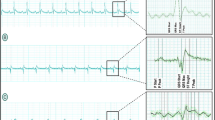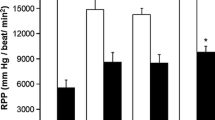Abstract
In many tissues the availability of l-cysteine is a rate-limiting factor in glutathione production, though this has yet to be fully tested in heart. This study aimed to test the hypothesis that supplying hearts with 0.5 mM l-cysteine would preserve glutathione levels leading to an increased resistance to ischaemia reperfusion.
Left ventricular function was measured in isolated perfused rat hearts before, during and after exposure to 45 min global normothermic ischaemia. Control hearts received Krebs throughout, whilst in treated hearts 0.5 mM l-cysteine was added to the perfusate 10 min before ischaemia, and was then present throughout ischaemia and for the first 10 min of reperfusion. Reperfusion injury was assessed from the appearance of lactate dehydrogenase (LDH) in the effluent. In two separate groups of control and treated hearts, ATP and glutathione (GSH) contents were measured at the beginning and end of ischaemia.
Hearts treated with 0.5 mM l-cysteine showed a significantly higher recovery of rate pressure product (16,256± 1288 mmHg bpm vs. 10,324± 2102 mmHg bpm, p < 0.05) and a significantly lower release of LDH (0.54± 0.16 IU/g wet weight vs. 1.44± 0.31 IU/g wet weight, p < 0.05) compared to controls. Also, the l-cysteine treated group showed significantly better preservation of ATP and GSH during ischaemia in comparison to control.
These results suggest that the mechanisms underlying the cardioprotective effects of 0.5 mM l-cysteine may include: increased anaerobic energy production either directly or through reduced degradation of adenine nucleotides; direct scavenging of free radicals; and/or improved antioxidant capacity through glutathione preservation.
Similar content being viewed by others
References
Pisarenko OI: Mechanisms of myocardial protection by amino acids: facts and hypotheses. Clin Exp Pharmacol Physiol 23: 627–633, 1996
Saez G, Thornalley PJ, Hill HAO, Hems R, Bannister JV: The production of free radicals during the autoxidation of cysteine and their effect on isolated rat hepatocytes. Biochim Biophys Acta 719: 24–31, 1982
Tani M: Effects of anti-free radical agents on Na+, Ca2+, and function in reperfused rat hearts. Am J Physiol 259: H137–H143, 1990
Griffith OW: Biologic and pharmacologic regulation of mammalian glutathione synthesis. Free Rad Biol Med 27: 922–935, 1999
Meister A, Anderson ME, Hwang O: Intracellular cysteine and glutathione delivery systems. J Am Coll Nutr 5: 137–151, 1986
Meister A, Anderson ME: Glutathione. Annu Rev Biochem 52: 711–760, 1983
Ceconi C, Bernocchi P, Boraso A, Cargnoni A, Pepi P, Curello S, Ferrari R: New insights on myocardial pyridine nucleotides and thiol redox state in ischaemia and reperfusion damage. Cardiovasc Res 47: 586–594, 2000
Dalla NS, Elmoselhi AB, Hata T, Makino N: Status of myocardial antioxidants in ischaemia-reperfusion injury. Cardiovasc Res 47: 446–456, 2000
Klawitter PF, Murray HN, Clanton TL, Angelos MG: Reactive oxygen species generated during myocardial ischaemia enable energetic recovery during reperfusion. Am J Physiol 283: H1656–H1661, 2002
Garlick PB, Davies MJ, Hearse DJ, Slater TF: Direct detection of free radicals in the reperfused rat heart using electron spin resonance spectroscopy. Circ Res 61: 757–760, 1987
Bolli R, Jeroudi MO, Patel BS, Dubose CM, Lai EK, Roberts R, Maccay PB: Direct evidence that oxygen derived free radicals contribute to postischemic myocardial dysfunction in the intact dog. Proc Natl Acad Sci USA 86: 4695–4699, 1989
Lesnefsky EJ, Moghaddas S, Tandler B, Kerner J, Hoppel CL: Mitochondrial dysfunction in cardiac disease: ischemia-reperfusion, aging, and heart failure. J Mol Cell Cardiol 33: 1065–1089, 2001
O’Connor E, Devesa A, Garcia C, Puertes IR, Pellin A, Vina JR: Biosynthesis and maintenance of GSH in primary astrocyte cultures: role of L-cystine and ascorbate. Brain Res 680: 157–163, 1995
Roberts JC, Francetic DJ: Time course for the elevation of glutathione in numerous organs of L1210-bearing CDF1 mice given the L-cysteine prodrug, ribcys. Toxicol Lett 59: 245–251, 1991
Shug AL, Madsen DC: Protection of the ischaemic rat-heart by procysteine and amino-acids. J Nutr Biochem 5: 356–359, 1994
Palacín M, Estévez R, Bertran J, Zorzano A: Molecular biology of plasma membrane amino acid transporters. Physiol Rev 78: 969–1054, 1998
Lin H, King N, McGivan JD, Suleiman M-S: Expression of ASCT2 and characterization of L-cysteine uptake in isolated rat cardiomyocytes. J Physiol 557P: 14PC, 2004
King N, Lin H, McGivan JD, Suleiman M-S: Aspartate transporter expression and activity in hypertrophic rat heart and ischaemia-reperfusion injury. J Physiol 556: 849–858, 2004
King N, McGivan JD, Griffiths EJ, Suleiman M-S: Glutamate loading protects freshly isolated and perfused adult cardiomyocytes against intracellular ROS generation. J Mol Cell Cardiol 35: 975–984, 2003
Tang L-D, Sun J-Z, Wu K, Sun C-P, Tang Z-M: Beneficial effects of N-acetylcysteine and cysteine in stunned myocardium in perfused rat heart. Br J Pharmacol 102: 601–606, 1991
Tsuboyama-Kasaoka N, Hosokawa Y, Kodama H, Matsumoto A, Oka J, Totani M: Human cysteine dioxygenase gene: Structural organization, tissue-specific expression and downregulation by phorbol 12-myristate 13-acetate. Biosci Biotech Biochem 63: 1017–1024, 1999
Faber NE, Vercellotti GM, Jacob HS, Pieper GH, Gross GL: Evidence for a role of iron-catalyzed oxidants in functional and metabolic stunning in the canine heart. Circ Res 63: 351–360, 1988
Obermayr RP, Schlütter K-D, Schäfer M, Spieckermann PG, Piper HM: Protection of reoxygenated cardiomyocytes against sarcolemmal fragility: The role of glutathione. Pflügers Archiv 438: 635–370, 1999
Laustiola K, Vuorinen P, Vapaatalo H, Metsa-Ketela T: Effects of cysteine and nitroglycerin on bovine heart guanylate cyclase and on tissue cyclic GMP and lactate of rat atria. Eur J Pharmacol 91: 301–304, 1983
Author information
Authors and Affiliations
Rights and permissions
About this article
Cite this article
Shackebaei, D., King, N., Shukla, B. et al. Mechanisms underlying the cardioprotective effect of l-cysteine. Mol Cell Biochem 277, 27–31 (2005). https://doi.org/10.1007/s11010-005-4817-y
Received:
Accepted:
Issue Date:
DOI: https://doi.org/10.1007/s11010-005-4817-y




